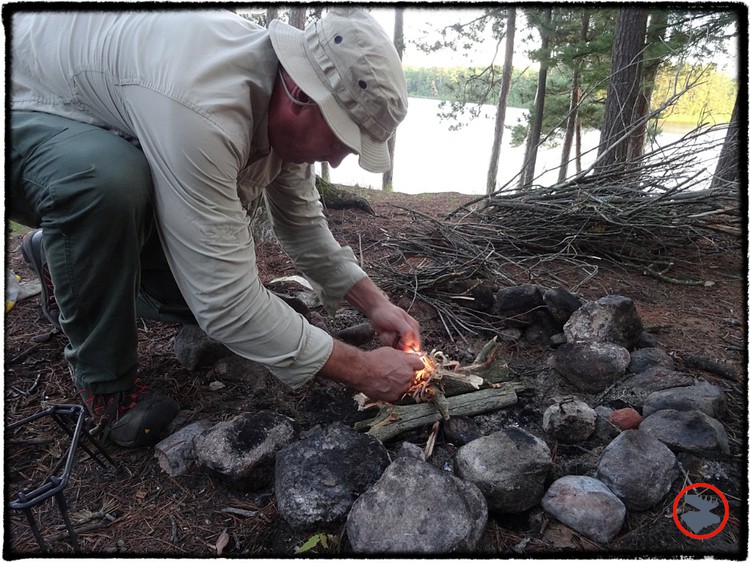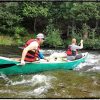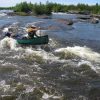Lost in the Scenery of Lost Canoe Lake
TRIP LOG: Submitted by Scott Oeth, February 2016
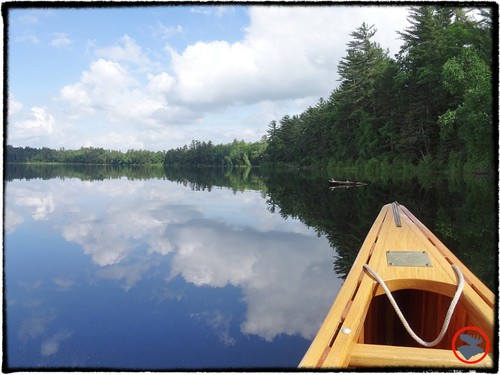
Lost Canoe Lake in Wisconsin offers a scenic paddle and an incredible amount of wildlife.
Sometimes, the best adventures are right next door. After talking with representatives from Wisconsin’s Northern Highlands-American Legion (NHAL) State Forest and YMCA Camp Manitowish at Canoecopia in Madison last Spring, I thought it would be fun to check out the canoe trails and lakes in that area, so that’s exactly what Linda and I did last weekend. After a day-long stopover at Camp Tomahawk Reservation where I taught wilderness survival skills to Boy Scouts of America camp counselors, we headed to Boulder Junction in Wisconsin’s northeast corner.
Northeastern Wisconsin has one of the highest concentrations of lakes in the world, as well as numerous rivers. This area is famous for its fishing and Boulder Junction is the self-proclaimed “Muskie Capital of the World.” People travel to Boulder Junction from all over the state (and neighboring states) with the hopes of catching a record-breaking muskie or walleye. But it’s not just fish fiends who enjoy the area. Much like Minnesota, there is a good number of people seeking reprieve from city life who own cabins on the lakes–their “up north” home.
We set out on Route 70 from Camp Tomahawk to Boulder Junction. If you decide to travel to this area from the Twin Cities, we highly recommend taking this route. It’s densely forested (transitioning from hardwoods to conifers as you travel northeast) with few towns or development, minimal traffic, and a variety of wildlife (we saw a fat black bear on the banks of the Chippewa River!). This road serves as the perfect prelude to your canoeing experience.
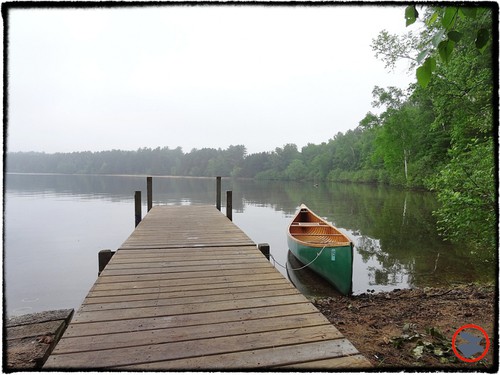
Fraser wood canvas canoe.
We started our trip on White Sand Lake. This was the first camping trip in our handmade, wood framed, canvas-covered canoe. I had been longing for a wood canvas canoe for about 15 years–ever since I first watched Bill Mason’s movie, “Water Walker,” and studied his masterful technique in his “Path of the Paddle” series. After years of waiting and an extensive search, I found a Fraser canoe custom made by Donald Fraser in 1980 for its previous owner. Prior to founding his own company, Mr. Fraser had worked for decades at the famous Chestnut Canoe Company (builders of the well-known Prospector and Pal canoes favored by Bill Mason). When Chestnut closed its doors, Mr. Fraser bought some of the canoe forms and continued making custom canoes. The one I got my hands on is a 17′ Cruiser XL model, also called “Cronje.”
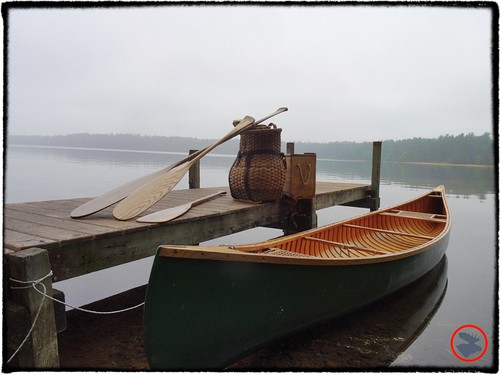
Fraser wood canvas canoe on White Sand Lake in Wisconsin.
A few notes about this piece of craftsmanship:
A few notes about this piece of craftsmanship:
- The Cronje is narrow, has fine entry lines, a round bottom, and glides effortlessly across calm waters at fast speeds.
- It has low initial stability and (supposedly) good secondary stability.
- The famous Keewaydin canoe tripping camps used this same model on some of their trips and Heb Evans from the camp featured it in his book, “Canoeing Wilderness Waters.”
As we pushed off, we were both immediately worried we were in for a fast, cold dunking! Since I had just picked up the canoe late last summer, and previously used it on solo trips only (I was always kneeling mid canoe and never had any issues with stability), I hadn’t fully realized how unstable the canoe could be. Now that it was loaded with gear for the next couple of days and another paddler, it felt mighty squirrelly. Many canoes settle and feel more stable with added gear, so the difference in stability and how that could impact your trips is definitely something to consider, and test, when buying a canoe. Although we never went for a swim, Linda was sure we were going to be wet in short order. We needed to make some adjustments. Realizing the canoe seats were too high and positioned far in the narrow ends of the boat, we slid off the seats and knelt low. I adjusted some of the gear to ensure we weren’t top heavy, and we set out again with much more stability. Linda was able to slowly relax her grip on the paddle and allow blood to flow to her fingertips once more. We’ll be looking into lowering and slightly repositioning the seats for future trips, and we will also be sure to keep the kneeling pads at hand!
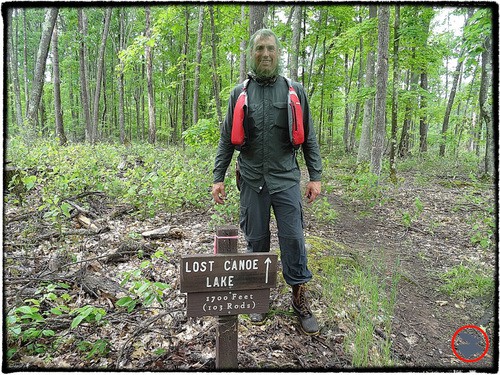
This was one of the buggiest canoe trips ever. The head net really helped to keep the mosquitos at bay.
We easily found the well-marked portage trail from White Sand Lake to Lost Canoe Lake. The portage trail was steep, not all that long, continuously marked, and impressively clear as far as portage trails go. However, it was like pushing through a wall of mosquitos! With all the camping and wilderness trips I’ve done, I’m going to put this year’s Wisconsin mosquito herd right near the top. Truly notable for their numbers and viciousness! We started along the portage trail wearing only our life vests and clothes, but we soon stopped to add head nets, and then stopped again later to put on gloves. If there was even one inch of skin showing, the mosquitos found it. They were insatiable and relentless.
Once we were on Lost Canoe Lake, we found a high campsite (we figured the high ground and breeze would help keep away the mosquitos) with a great view of the lake that promised to offer a beautiful sunset. We unloaded the canoe and with no one else within eyesight, we initially felt like we had the place to ourselves. We even enjoyed a relatively bug free hour or so while setting up. (Note: After we started paddling around Lost Canoe Lake, we ran into a handful of people, most of whom had cabins in the area. We weren’t completely alone on the lake during the day; however, at night, it was dead quiet and couldn’t have been more peaceful.)
After base camp was set up, we set out to explore Lost Canoe Lake and neighboring lakes. Using solid Ash paddles with “Maine Guide” style grips from Dri-Ki Woodworking, we cruised with ease, taking in the lakes, forest, and wildlife. And the wildlife was everywhere! We spotted a fox, watched a bald eagle perched high atop a dead tree as it scouted food options, glided alongside a few loons (they weren’t too worried about our canoe and swam right by us), got an up-close look at a turtle lounging in the afternoon sun, and even saw a doe and fawn taking an afternoon stroll on the lakeshore. As we pulled up near the shore for a closer look, the fawn got a little spooked by our canoe and ran the opposite way of the doe. I whistled at the fawn, and it immediately jumped in the lake and started swimming toward the canoe. It came right up next to the canoe, bumped into it, turned around, and went back to its mom.
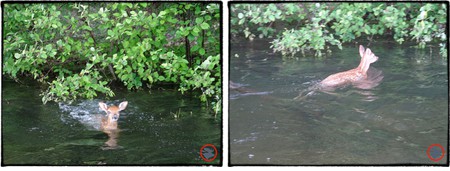
The fawn heard my whistle and swam out to our canoe! After swimming up to our canoe, the fawn returned to its mom.
The scenery in NHAL Forest was as impressive as the wildlife. Our day started out cloudy and we thought we were in for rain showers, but by late morning, it was hot and sunny. With the weather on our side, we spent the day on the water. The recent onslaught of rain allowed us to paddle through areas that clearly are not usually under water. We ventured over to other lakes, including Escanaba Lake (the portage trail for Palette Lake eluded us–we think it was flooded). The portage trail to Escanaba Lake was short, but it was so overrun with mosquitos that it was unbearable. Large areas of swampy water along the trail served as mosquito mass wave death squad staging areas, so we raced along the trail, eager to get back on the open water.
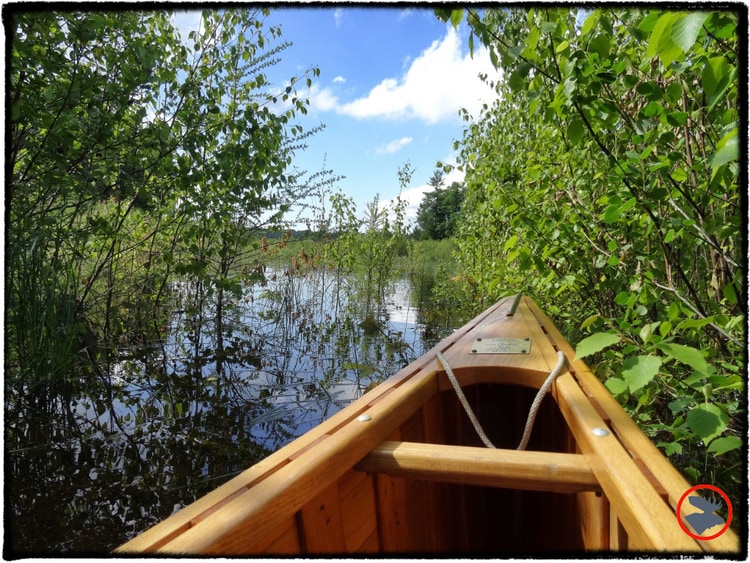
We felt like Bogie and Hepburn in the African Queen at certain points as we glided through trees and shrubs in flooded areas.
After paddling all day, we decided to head back to camp before we lost too much light. Like most campsites, all the good firewood had already been picked over. There were plenty of dead fallen conifers on the way back to camp, so we pulled over to load up the canoe. I chopped up enough firewood to last us the night, and we barged back to camp with our load.
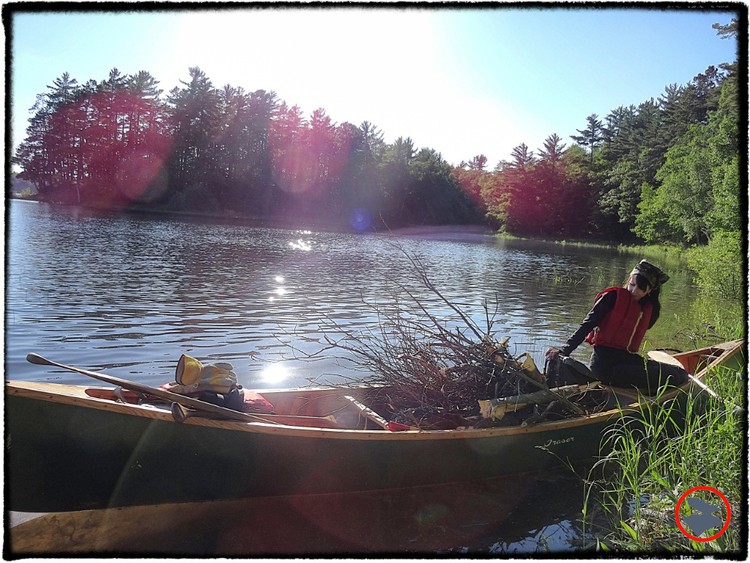
Fallen conifers alongside the lake were perfect for the campfire.
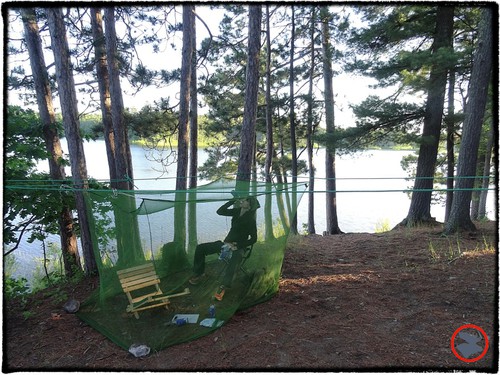
Cheap and light-weight, this mosquito net was a life saver at camp when not even DEET could keep away the mosquitos.
The campsite was set up well with ample room for our cooking and eating area to be situated a good distance away from our sleeping area. This set up was a nice feature given the bear population in the area–best to keep all the food and cooking scents far from the tent. By the time we returned to camp with our firewood and started preparing dinner, the mosquitos were on to us–and they were out in full force. We used high DEET bug spray and wore some Mossy Oak bandanas pretreated with permethrin that I had found at a discount store (those handkerchiefs didn’t seem to help much, but we’ve had good results spraying our clothes with permethrin before trips in the past), but neither worked to keep the mosquitos from attacking. To create a mosquito-free sanctuary, we ran a rope triangle around three trees and strung up a mosquito net. This cheap and light-weight net was a life saver, or at least a sanity saver, and was the perfect lounge for a campsite happy hour. Break out the cheese and wine! We strongly recommend adding a net to your pack the next time you’re heading out into the woods–especially during a year when the mosquitos are so fierce and so thick!
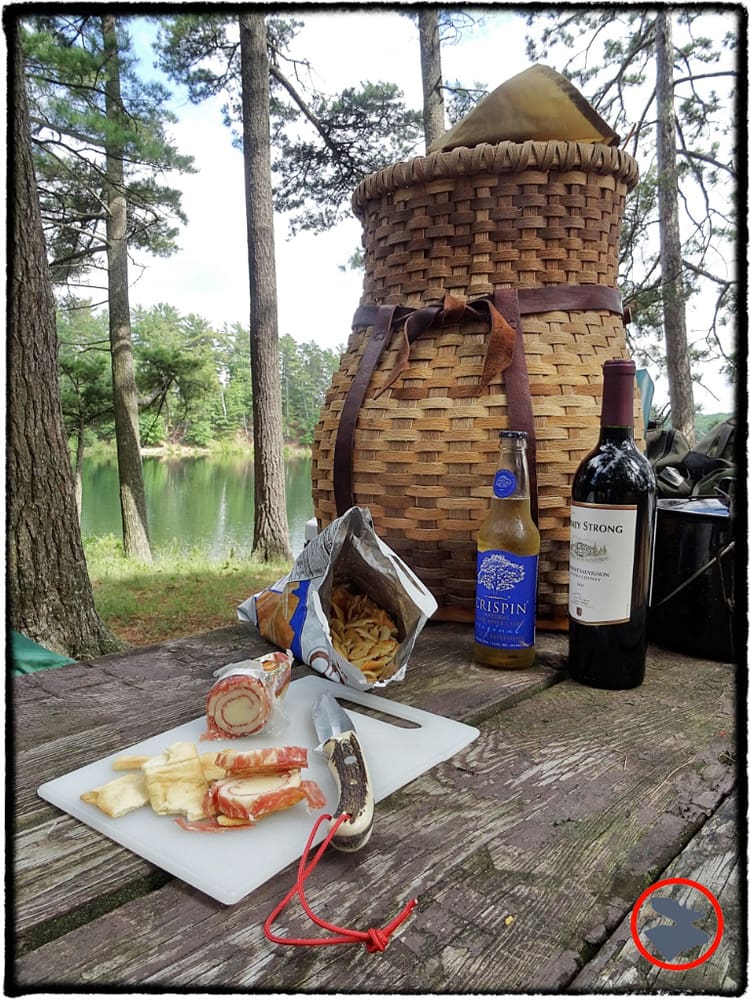
One of the great things about this area is that you can bring in bottles and cans and other materials not allowed in places like the Boundary Waters Canoe Area. We took full advantage of this fact when provisioning. Of course, you need to pack out what you pack in.
While I took the opportunity to practice making feather sticks and using a ferro rod to start the fire, Linda worked on dinner. We used a deep steel skillet to prepare a “shore lunch” dinner of potatoes and onions with fish and sausage, and then put on the lid to use it Dutch oven style to bake some hot, gooey, peanut butter chocolate chip cookies! Good thing bears don’t like hot, gooey, peanut butter chocolate chip cookies…ummm, Honey, where’d you put the bear spray? Expert camping tip for you: bushcraft chopsticks carved from sticks work really well with shore lunch. This tip has nothing to do with my forgetting the silverware.
We wanted to make note of a few interesting points regarding this area as a lake country canoe camping destination:
Pro: Campsites. In Wisconsin’s NHAL, you can reserve some campsites. Permits are not needed, most of the sites have no camp fee, and there doesn’t appear to be a limit on group size. If you’re traveling during a popular weekend, knowing you have a campsite reserved can alleviate stress.
Pro: Many access points. With all of the access points, the NHAL can make a potentially busy weekend easier because you can quickly get in and on the lakes, and you can quickly get out and off the lakes.
Pro: A variety of lakes to suit your taste. Some lakes in this region are designated “Wilderness,” “Wild,” or “Scenic.” There are also several great river trails in the area. Study the many possible routes and sites before heading out, so you have the canoe camping experience you want. As well, there are undeveloped, motor-free lakes, and there are busy lakes ringed with cabins.
Pro: In Wisconsin’s NHAL, you can bring in cans, bottles, and other materials not allowed in the BWCA. This increases your food and beverage options from dehydrated foods to just about anything–making dinner almost effortless.
Con: It’s not the BWCA. It is not protected as a wilderness in the same way as the BWCA, and without those special protections (many of which we inferred were negatives in the points above, but didn’t necessarily mean that–they just add complexity to a BWCA trip, but also protect it’s wild beauty), you run the risk of encountering large, noisy groups, or following up on slob campers. NHAL is a mixed-use area, with some roads and development. Wisconsin’s NHAL is a solid offering, but does not provide the same wilderness experience as other larger protected areas.
Con: It’s a popular destination. There are a lot of people in Wisconsin’s NHAL–from fishermen and paddlers, to vacationers and “up north” cabin weekenders. With generally more usage and multiple use areas, Wisconsin’s NHAL isn’t guaranteed to provide you with the solitude you may desire. If you want complete isolation in this area, we recommend camping on a canoe-access only lake, like Escanaba Lake.
Con: Sound. The sounds of civilization were never too far off. We could hear some traffic on nearby roads as we paddled around certain parts of the lakes, although our evening was perfectly silent.
Overall, it was a fantastic canoe camping trip. If you’re planning an introductory canoe camping trip for you or anyone you know, this is a great destination. Yes, Linda is plotting to massacre the world’s mosquitos (she’s convinced no one will miss them), but with the incredible scenery, the up-close-and-personal experience with all the wildlife, and the solitude of the quiet night, it is a trip worth repeating. Just don’t forget your head net!
Read more at the Bull Moose Patrol blog>
